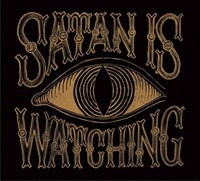 The Devil occupies a unique space in American Christian culture. Some denominations see him lurking around every corner, while others are convinced there’s not really any such thing as a personal Satan. Most of us are probably somewhere in the middle: we’ve heard and read all the Biblical stories of Satan but aren’t quite sure what to make of him.
The Devil occupies a unique space in American Christian culture. Some denominations see him lurking around every corner, while others are convinced there’s not really any such thing as a personal Satan. Most of us are probably somewhere in the middle: we’ve heard and read all the Biblical stories of Satan but aren’t quite sure what to make of him.
Enter Tripp York’s delightful, hilarious and thoughtful book The Devil Wears Nada. Tripp teaches Religious Studies, and once during a class debate, a student suggested that we could know for sure that God exists if we can prove Satan exists. Since, as Tripp notes, apologetics has failed to convince anyone who wasn’t already convinced, he signs up for the quest.
Having grown up Nazarene, Tripp witnessed all manners of daily evils attributed to Satan. So he begins his quest at his roots, seeking out the Devil in traditionalist, Evangelical circles. Unfortunately, though many of the leaders he interviews frequently cited evidence of Satan working (including, memorably, a CD skipping during a Sunday morning music special), none of them actually point him to the Prince of Darkness. Tripp observes that
Using Satan as an explanation for everything you personally do not like is not only theologically problematic, it is also terribly dangerous. It opens the door to the rampant demonization of other people despite Christianity’s claim that all humans, regardless of creed, race, nationality, gender, or faith tradition (or, lack thereof), are created in the image of God.
What really makes the book work is Tripp’s uncanny ability to mix humor with insight, reflection and theology.
He’s reminiscent of A. J. Jacobs or Matt Mikalatos. While researching demonic possession, Tripp stumbles across the story of (in)famous exorcist Cindy Jacobs, who once had to cast a demon out of her cat. Because the cat was snarling, scratching and yowling. In one of his many clever asides, Tripp notes
This is not really a theological question, but I wonder if the author has been around many other cats.
After failing to find Satan among the Protestants, Tripp turns to the Scriptures. He problematizes our traditionally reductionist readings of Job and Genesis 3, pointing out that, in the Old Testament, Satan was an angel, an agent of God.
 Tripp then moves to a couple of paradigmatic New Testament texts: Jesus and the Legion of demons (Mark 5) and Jesus’ wilderness temptation. On Satan’s claim to possess the nations, Tripp agrees, channeling John the Revelator and noting that
Tripp then moves to a couple of paradigmatic New Testament texts: Jesus and the Legion of demons (Mark 5) and Jesus’ wilderness temptation. On Satan’s claim to possess the nations, Tripp agrees, channeling John the Revelator and noting that
The empirical evidence behind our history of monarchies, empires, and nation-states is more than enough evidence to suggest that there is a real “beast” behind governmental authorities.
Having struck out in the Church, and not finding much guidance in the Scriptures as to where to locate a personal Satan in all the places Christians say he lives. Tripp visits a Unitarian and a Wiccan. His exchanges with them fail to unearth the Devil, but Tripp problematizes the beliefs and practices of both as deftly as he’d skewered the Evangelical pastors and leaders he’d interviewed.
Finally, Tripp tries out some actual Satanism, but realizes that he can’t tell the Satanists from many Christians:
If [Christians] follow a person whose kingdom is not of this world, what are they doing propping up an empire that has more than eight hundred military bases stationed throughout the globe? You simply cannot get any more “worldly” than that… [America] is the epitome of “pride, strength, and force.” When Cavendish claims that Satanists admire these cardinal virtues of nationalism, I just have to wonder how American Christians differ on the subject.
Having failed to find Satan anywhere else, Tripp elects to throw the remnants of his caution to the wind and sell his soul to the Devil.
But a backwoods crossroad at midnight, several Satanic texts, cards, dice and Jack Daniels elicit nary a pitchfork or bifurcated red tail. Not that Tripp was expecting any success:
I do not, and I think I can honestly say this and remain thoroughly orthodox, believe in the existence of the soul—at least not in the sense of it eternally existing, being housed by my flesh, and returning to some heavenly realm after I die. If I have such an eternal soul, and such an account is far more pagan than Christian, then the Devil can have it.
 If the book has a flaw, it might lie right there: though Devil Wears Nada is packaged as a memoire, Tripp writes with the air of a person who already knew all the answers before he started. While it’s delightful and hilarious to watch him play – ahem – Devil’s Advocate to every person both Christian and non- he interviews, there’s no sense of discovery.
If the book has a flaw, it might lie right there: though Devil Wears Nada is packaged as a memoire, Tripp writes with the air of a person who already knew all the answers before he started. While it’s delightful and hilarious to watch him play – ahem – Devil’s Advocate to every person both Christian and non- he interviews, there’s no sense of discovery.
Not that Tripp is being dishonest. He knows the questions he asks are serious. His problem isn’t that he disagrees with those he questions; it’s that their positions don’t stand up to questions.
What’s troubling is not Tripp’s search, but how little those he interviewed have thought through the positions they hold.
At every turn, Tripp’s honest (and entertaining) questions poke holes in the traditional and popular conceptions of Satan. In the end, Tripp comes round to affirm the orthodox position of Satan as non-Person:
The very concept of “person” requires some sort of relation that is recognizable in each creature of God as one of God’s creatures… Within such a linguistic framework, Satan could only ever be an “un-person,” because with the radical decision against God comes the disintegration of personhood.
 Tripp ends reflecting on how easily Christians apply not only Satan, but God too to our everyday circumstances. Whether it’s a pro-athlete catching a football or hurricanes striking cities, Christians are quick to assign cosmic responsibility for every little thing. In fact, little of what Christians believe about Satan is actually consistent with a biblical worldview. Coming full-circle to the picture of the Devil he was raised with, Tripp observes that
Tripp ends reflecting on how easily Christians apply not only Satan, but God too to our everyday circumstances. Whether it’s a pro-athlete catching a football or hurricanes striking cities, Christians are quick to assign cosmic responsibility for every little thing. In fact, little of what Christians believe about Satan is actually consistent with a biblical worldview. Coming full-circle to the picture of the Devil he was raised with, Tripp observes that
I fear that any understanding of God and Satan locked in battle over minutiae creates the kind of dualism that is at odds with the Christian canon. It tempts us not only to fall into the realm of superstition, but also into heterodoxy.
Tripp’s quest for Satan finally leads him to conclude that we all might do well getting to know God better. And who can argue with that?
Bottom Line: An outstanding read that’s at once hilarious, challenging and deeply insightful. Tripp takes on the Devil, and we all reap the refreshing benefits.
YOUR TURN: Where does the Devil fit in your theology? How do you understand the nature of Evil?

